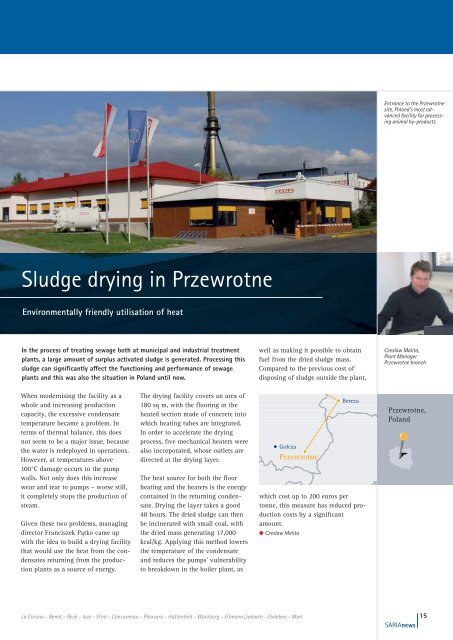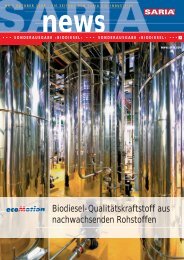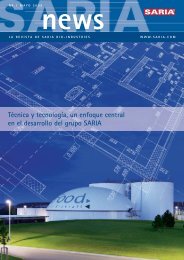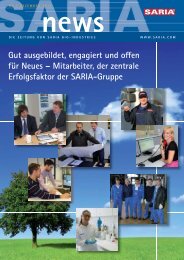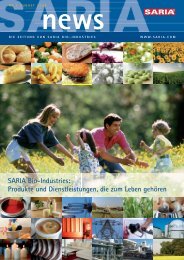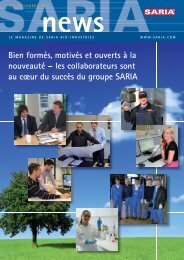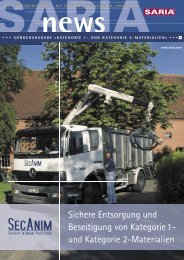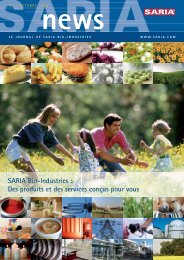A European group of companies - Saria Bio-Industries AG & Co. KG
A European group of companies - Saria Bio-Industries AG & Co. KG
A European group of companies - Saria Bio-Industries AG & Co. KG
You also want an ePaper? Increase the reach of your titles
YUMPU automatically turns print PDFs into web optimized ePapers that Google loves.
Entrance to the Przewrotne<br />
site, Poland’s most advanced<br />
facility for processing<br />
animal by-products<br />
Sludge drying in Przewrotne<br />
Environmentally friendly utilisation <strong>of</strong> heat<br />
In the process <strong>of</strong> treating sewage both at municipal and industrial treatment<br />
plants, a large amount <strong>of</strong> surplus activated sludge is generated. Processing this<br />
sludge can significantly affect the functioning and performance <strong>of</strong> sewage<br />
plants and this was also the situation in Poland until now.<br />
well as making it possible to obtain<br />
fuel from the dried sludge mass.<br />
<strong>Co</strong>mpared to the previous cost <strong>of</strong><br />
disposing <strong>of</strong> sludge outside the plant,<br />
Czesław Malita,<br />
Plant Manager<br />
Przewrotne branch<br />
When modernising the facility as a<br />
whole and increasing production<br />
capacity, the excessive condensate<br />
temperature became a problem. In<br />
terms <strong>of</strong> thermal balance, this does<br />
not seem to be a major issue, because<br />
the water is redeployed in operations.<br />
However, at temperatures above<br />
100°C damage occurs to the pump<br />
walls. Not only does this increase<br />
wear and tear to pumps – worse still,<br />
it completely stops the production <strong>of</strong><br />
steam.<br />
Given these two problems, managing<br />
director Franciszek Pątko came up<br />
with the idea to build a drying facility<br />
that would use the heat from the condensates<br />
returning from the production<br />
plants as a source <strong>of</strong> energy.<br />
The drying facility covers an area <strong>of</strong><br />
180 sq m, with the flooring in the<br />
heated section made <strong>of</strong> concrete into<br />
which heating tubes are integrated.<br />
In order to accelerate the drying<br />
process, five mechanical heaters were<br />
also incorporated, whose outlets are<br />
directed at the drying layer.<br />
The heat source for both the floor<br />
heating and the heaters is the energy<br />
contained in the returning condensate.<br />
Drying the layer takes a good<br />
48 hours. The dried sludge can then<br />
be incinerated with small coal, with<br />
the dried mass generating 17,000<br />
kcal/kg. Applying this method lowers<br />
the temperature <strong>of</strong> the condensate<br />
and reduces the pumps’ vulnerability<br />
to breakdown in the boiler plant, as<br />
Gołcza<br />
Przewrotne<br />
Bereza<br />
which cost up to 200 euros per<br />
tonne, this measure has reduced production<br />
costs by a significant<br />
amount.<br />
● Czesław Malita<br />
Przewrotne,<br />
Poland<br />
La <strong>Co</strong>runa – Benet – Rezé – Issé – Vitré – <strong>Co</strong>ncarneau – Plouvara – Hüttenfeld – Würzburg – Eltmann Limbach – Elxleben – Marl<br />
15<br />
SARIAnews


